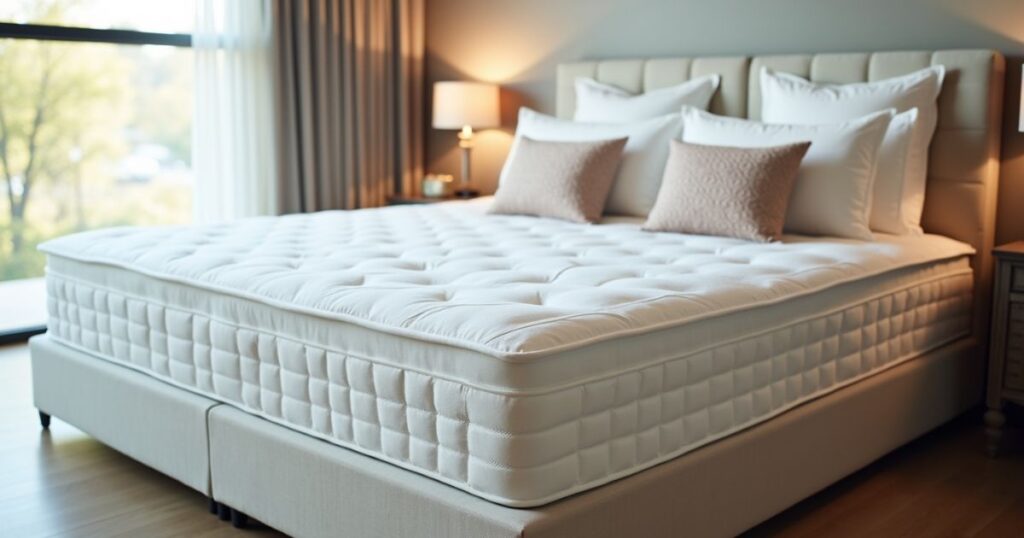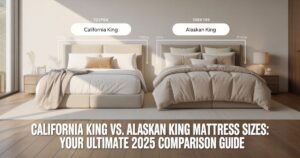You’ve probably tossed and turned on a cramped mattress one too many times. Your partner rolls over, and suddenly you’re clinging to the edge like a mountain climber. Sound familiar? Upgrading from queen to king might be the game-changer you desperately need.
King size beds have become the gold standard for American master bedrooms. They offer that coveted extra space without overwhelming most bedroom layouts. But before you commit to this sleeping upgrade, understanding the exact dimensions and variations is crucial.
Let’s dive into everything you need to know about king bed dimensions, from standard measurements to luxury oversized options that’ll make you never want to leave your bedroom.
What is a King Bed?
A king bed represents the premium choice in standard mattress sizes. Also called an Eastern king, this sleeping surface provides substantial space for couples, families, or anyone who values sprawling room during sleep. The standard king mattress offers each sleeper roughly 38 inches of personal width that’s more space than a twin bed provides.
Most American homes built after the late 1940s include master bedrooms designed specifically to accommodate king beds. They’ve become an expected feature in upscale homes. The king size strikes that perfect balance between spaciousness and practicality. Unlike specialty oversized options, standard king mattresses work with readily available bed frames and bedding accessories.
Many sleepers choose king beds because they dramatically reduce partner disturbance. When your significant other moves, you barely notice. That extra width creates a buffer zone that protects your sleep quality throughout the night.
Shop Turmerry Mattress Sizes
Turmerry offers exceptional king mattresses crafted from organic materials. Their collection includes memory foam king mattresses, latex king mattresses, and hybrid options designed for various sleeping preferences. Each mattress meets strict quality standards while providing the comfort you deserve.
Their king size selection accommodates standard 76 × 80 inch dimensions perfectly. You’ll find options for every budget without sacrificing quality or durability. Turmerry’s commitment to natural materials means you’re investing in healthier sleep.
Visit their website to explore the full range of king mattress options. They provide detailed specifications and customer reviews. Their transparent approach helps you make informed decisions about your mattress investment.
Shop Turmerry Mattress Topper Sizes

Adding a king mattress topper transforms your sleep experience. Turmerry’s topper collection includes latex and memory foam options designed specifically for 76 × 80 inch king mattresses. These toppers add comfort layers without requiring complete mattress replacement.
Their toppers range from 2 to 4 inches thick. Each provides targeted pressure relief and temperature regulation. Whether you need softer cushioning or firmer support, Turmerry offers customizable comfort solutions.
The king size toppers attach securely to prevent shifting during sleep. They’re made from hypoallergenic materials that resist dust mites. Check out their collection to find the perfect comfort enhancement for your existing king bed.
What Are the Dimensions of a Standard King Size Bed?
Exact Measurements You Need to Know
A standard king mattress measures 76 inches wide × 80 inches long. In metric terms, that’s 193 × 203.5 cm. Converting to feet gives you approximately 6.33 × 6.66 feet. This provides each sleeper with 38 inches of personal width when two adults share the bed.
The surface area totals 6,080 square inches of sleeping space. That’s significantly more generous than a queen mattress (4,800 square inches). For comparison, you’re gaining 1,280 additional square inches enough space to dramatically improve sleep quality.
When shopping for a bed frame for king mattress, look for dimensions slightly larger. Most frames measure 78–81 inches wide × 82–85 inches long. This extra room accommodates bedding and ensures proper mattress fit.
How King Size Compares to Other Beds
Here’s a comprehensive comparison of standard mattress sizes:
| Mattress Size | Width × Length (inches) | Width × Length (cm) | Best For |
|---|---|---|---|
| Twin | 39 × 75 | 99 × 191 | Single children/adults |
| Twin XL | 38 × 80 | 97 × 203 | College dorms, tall teens |
| Full | 54 × 75 | 137 × 191 | Single adults, guest rooms |
| Queen | 60 × 80 | 152 × 203 | Couples, smaller bedrooms |
| King | 76 × 80 | 193 × 203.5 | Couples, master bedrooms |
| California King | 72 × 84 | 183 × 213 | Tall individuals, narrow rooms |
The king provides 16 additional inches of width compared to queen mattresses. That might not sound dramatic, but it’s the difference between cramped sleeping and luxurious comfort.
History of King Size Bed

The king size bed emerged during the second half of the 20th century as American homes grew larger. Before World War II, most couples slept on full size beds (54 × 75 inches). Post-war prosperity changed everything about bedroom furniture.
In 1961, mattress manufacturers standardized king dimensions at 76 × 80 inches. This standardization made bedding production easier and more affordable. Suddenly, luxury bedroom trends weren’t just for the wealthy middle-class families could enjoy spacious sleeping too.
California introduced the Western king (now called California king) around the same time. It measured 72 × 84 inches, designed specifically for taller sleepers. The evolution of bed sizes reflected changing American lifestyles and our growing emphasis on quality sleep.
Interestingly, the term “king” was pure marketing genius. It conveyed opulence and luxury that appealed to aspirational buyers. By the 1970s, king beds had become standard features in new master bedroom construction throughout the United States.
What to Consider Before Choosing a King Size Bed?
Room Space
Bedroom furniture planning starts with accurate measurements. You’ll need a minimum room size of 12 × 12 feet to accommodate a king bed comfortably. Ideal dimensions? Aim for 13 × 13 feet or larger for proper bedroom traffic flow.
Measure your space before shopping. Leave at least 24-30 inches of clearance on each side for easy movement. You’ll also need 36 inches at the foot for comfortable access. These measurements prevent that cramped, claustrophobic feeling that ruins bedroom aesthetics.
Don’t forget doorways and stairwells! Measure these critical pathways carefully. Standard doorways are 32-36 inches wide. Many king mattresses arrive compressed, but traditional innerspring options require careful maneuvering. Plan your delivery route to avoid frustrating surprises.
Bed Frame
Your bed frame dimensions must support 500+ pounds minimum. This accounts for the mattress weight (90-200 pounds), two sleepers, and bedding. Platform frames eliminate the need for box springs, while traditional frames require additional support.
Material choices include solid wood, metal, and upholstered frames. Wood provides durability and timeless aesthetics. Metal frames offer modern styling with lighter weight. Upholstered options add plush comfort but require more maintenance.
Storage integration has become increasingly popular. Many king frames now include built-in drawers underneath. This maximizes bedroom space while providing practical organization. Assembly difficulty varies some frames require professional setup, while others feature simple construction.
Number of Sleepers
Couples king bed setups work beautifully for two adults. Each person gets 38 inches of width more than a twin mattress provides. This creates that crucial buffer zone for undisturbed sleep.
Families often appreciate the extra space for bed for pets or occasional child co-sleeping. A king mattress easily accommodates parents plus one or two children for storytime. The spacious surface prevents anyone from feeling squeezed.
Even single sleepers enjoy king beds. The extra comfort from extra space allows unlimited stretching and position changes. If you’re a restless sleeper who moves frequently, that additional room proves invaluable. Solo sleeping on a king feels absolutely decadent.
Budget
Budget for king mattress purchases ranges dramatically. Entry-level options start around $500 for basic innerspring models. Mid-range memory foam and hybrid mattresses cost $1,000-$2,500. Premium latex and luxury models easily exceed $5,000.
Don’t forget additional expenses. A quality bed frame adds $300-$1,500. King size sheets cost $50-$200 per set. A king size comforter runs $100-$400. Pillows, mattress protectors, and toppers add several hundred more.
However, this represents a smart mattress investment. You spend roughly one-third of your life sleeping. Quality sleep directly impacts health, productivity, and overall wellbeing. Financing options make premium mattresses accessible through manageable monthly payments.
King Size Variations and Bed Dimensions

California King
The California king bed dimensions measure 72 × 84 inches (182.88 × 213.36 cm, or 6 × 7 feet). This provides 4 extra inches of length compared to standard king mattresses. The tradeoff? You lose 4 inches of width.
California king mattress options suit taller individuals beautifully. Anyone over 6’2″ appreciates that extra legroom significantly. The narrower width works perfectly in longer, narrower master bedrooms where standard king beds feel disproportionate.
Bedding availability has improved dramatically for Cal King sizes. Most major retailers stock California king sheets and comforters readily. Prices remain comparable to standard king bedding, though selection may be slightly more limited.
Wyoming King Bed Dimensions
Wyoming king dimensions create a perfect square: 84 × 84 inches (213.36 × 213.36 cm, or 7 × 7 feet). This oversized mattress provides equal length and width for ultimate sleeping flexibility.
The Wyoming king offers 6,976 square inches of surface area significantly more than standard king beds. Families with young children or multiple pets particularly appreciate this generous space. Everyone fits comfortably without anyone getting pushed to the edges.
However, Wyoming king mattresses typically require custom orders. Expect to pay premium prices ($2,000-$5,000+). Finding bedding proves challenging you’ll likely need custom-made sheets and comforters. Room requirements jump to at least 13 × 13 feet minimum.
Texas King Bed Dimensions
Everything’s bigger in Texas, including mattresses. Texas king mattress size measures 80 × 98 inches (203.2 × 248.92 cm, or 6.66 × 8.1 feet). This oversized king bed emphasizes length over width.
That extra length accommodates very tall individuals or families who prefer sleeping lengthwise. The Texas king provides ample space for parents and children during family bed arrangements. It’s essentially a super-long king option.
Custom manufacturing is standard for Texas king beds. You’ll invest $2,500-$6,000 typically for quality mattresses. Room dimensions need to be substantial 14 × 16 feet minimum recommended. Bedding requires custom orders, adding complexity and cost to your purchase.
Vermont King Bed Dimensions
The Vermont king bed dimensions measure 96 × 96 inches (243.84 × 243.84 cm, or 8 × 8 feet). This creates an enormous square sleeping surface that’s truly luxury-level.
With 9,216 square inches of sleeping space, Vermont king mattresses accommodate large families comfortably. Couples who want maximum separation during sleep find this size perfect. The spacious surface eliminates virtually all partner disturbance issues.
Commercial availability is extremely limited. Most Vermont king mattresses require specialized custom manufacturing. Expect investments of $3,000-$7,000+. Your bedroom needs minimum dimensions of 15 × 15 feet. Everything frame, bedding, accessories requires custom ordering.
Alaskan King Bed Dimensions
The ultimate in luxury bed sizing, Alaskan king bed size measures 108 × 108 inches (274.32 × 274.32 cm, or 9 × 9 feet). This massive square provides an astonishing 11,664 square inches of sleeping surface.
Alaskan king mattress options suit families who regularly co-sleep with multiple children and pets. Some people simply want that ultimate luxury sleeping experience. The Alaskan king delivers unmatched spaciousness and comfort.
However, practicality becomes challenging. Room requirements are enormous minimum 16 × 16 feet recommended. Custom manufacturing is mandatory, with prices starting around $5,000 and often exceeding $10,000. Moving and installation require professional assistance. Every accessory needs custom fabrication.
What is a Split King Mattress?
A split king mattress consists of two twin XL mattresses (38 × 80 inches each) placed side-by-side. Combined, they create the exact dimensions of a standard king bed: 76 × 80 inches total.
This configuration offers customizable comfort for couples with different sleeping preferences. One partner prefers firm support while the other needs plush cushioning? No problem each person selects their ideal mattress. This eliminates the compromise inherent in sharing a single mattress.
Split king setups work beautifully with adjustable bed frames. Each side operates independently, allowing personalized positioning for reading, watching TV, or addressing medical needs like acid reflux or sleep apnea. This flexibility has made split configurations increasingly popular.
The main drawback? A visible gap exists between the two mattresses. Bridge pads help minimize this separation. Fitted sheets designed specifically for split king configurations manage the gap effectively. Standard king flat sheets and comforters work perfectly over both mattresses.
Cost comparison shows split king setups typically cost 10-30% more than single king mattresses. You’re essentially purchasing two separate mattresses plus specialized bedding. However, the personalized comfort justifies the additional investment for many couples.
Which is the Best Option for Couples – A Queen Size Mattress or a King Size Mattress?
Choosing a king bed versus queen depends on several critical factors. Let’s break down this common dilemma clearly.
Queen mattress dimensions measure 60 × 80 inches. That provides each sleeper with 30 inches of personal width. Standard king dimensions (76 × 80) give each person 38 inches. Those extra 8 inches per person make a dramatic difference in sleep quality.
Queen beds work better when:
- Your bedroom measures less than 12 × 12 feet
- Budget constraints limit mattress spending to under $800
- You’re a single sleeper who occasionally hosts guests
- Moving frequently makes smaller sizes more practical
- Your body frames are petite (under 5’8″ and 160 pounds)
King beds prove worth the investment when:
- Either partner is a restless sleeper who moves frequently
- You regularly co-sleep with children or pets
- Both partners are larger or taller individuals
- Your master bedroom comfortably exceeds 12 × 12 feet
- Sleep quality ranks as a top health priority
Here’s the truth: couples king bed setups dramatically reduce sleep disruption. Studies show partners on queen mattresses experience 30-50% more sleep disturbances compared to king bed sleepers. That translates to better health, improved mood, and enhanced relationship quality.
Pros of King Size Bed
1. Extra Comfort from Extra Space
Sleeping comfort king bed options provide that’s simply unmatched. Each sleeper enjoys 38 inches of personal width more than a twin bed offers. You can stretch completely without encountering your partner.
This spacious sleeping area reduces nighttime disturbances significantly. When your partner shifts positions, rolls over, or gets up, you barely notice. That protective buffer zone maintains your deep sleep cycles throughout the night.
Temperature regulation improves with extra space too. Air circulates better between sleeping bodies. You’re less likely to overheat from partner proximity. This particularly benefits hot sleepers who struggle with temperature management.
The psychological comfort matters too. There’s something inherently restful and luxurious about sprawling across a generous sleeping surface. No more feeling cramped or restricted. You experience genuine relaxation that enhances overall sleep quality.
2. Space for Quality Time
Beyond sleeping, king beds create perfect spaces for cozy lifestyle activities. Morning coffee in bed becomes genuinely comfortable when you’re not cramped. Reading together doesn’t require awkward positioning.
Families appreciate the generous surface for children’s storytime. Kids pile on without crowding anyone out. These cherished family moments happen more naturally on spacious mattresses.
Bed for pets situations work much better on king mattresses. Your furry friends can snuggle without pushing you off the bed. Everyone coexists peacefully with room to spare.
Couples find that extra space enhances intimacy too. There’s room for comfortable cuddling without feeling squeezed. The psychological comfort of abundant space actually improves relationship quality and connection.
3. Fits into Most Master Bedrooms
Modern master bedroom bed size standards typically accommodate king beds perfectly. Homes built after 1960 usually include master bedrooms designed specifically for this size. It’s become the expected standard in American housing.
This sizing choice actually enhances home resale value. Buyers expect master bedrooms capable of fitting king beds. Homes with appropriately sized master suites sell faster and command higher prices.
Bedroom furniture planning remains flexible even with king beds. Most 12 × 12 foot or larger bedrooms accommodate king mattresses plus nightstands, dressers, and additional furniture. You’re not sacrificing functional space for sleeping comfort.
The proportions simply look right. King beds don’t overwhelm appropriately sized master bedrooms. They create that balanced, finished aesthetic that makes bedrooms feel complete and well-designed.
4. Accessories Are Easily Available
Bedding accessories for king mattresses are ubiquitous. Every major retailer stocks king size sheets, comforters, and pillows. This widespread availability creates competitive pricing and extensive selection.
You’ll find king size sheets in every imaginable material, thread count, and pattern. From budget-friendly options to premium Egyptian cotton, choices abound. Replacement bedding is always convenient and accessible.
Deep-pocket sheets king sizes accommodate thick mattresses and toppers easily. Most king sheets feature pocket depths from 12-22 inches. This ensures proper fit even with pillow-top mattresses or added topper layers.
Online shopping makes finding specialty items effortless. Cooling sheets, hypoallergenic options, and organic bedding are readily available. The mature market for king bedding means you’ll never struggle to find what you need.
Cons of King Size Bed
1. Expensive
Budget considerations become significant with king mattresses. Entry-level models start around $500, but quality options typically begin at $1,000. Premium mattresses easily exceed $3,000-$5,000.
Bedding costs accumulate quickly too. King sheets cost 20-40% more than queen sizes. A quality set runs $80-$200. You’ll need multiple sets for rotation. King size comforter prices range from $150-$500 for quality options.
King mattress topper additions cost $200-$600 depending on materials. Mattress protectors add another $50-$150. King pillows cost $30-$100 each, and you’ll need 4-6 for proper bed styling.
Over the mattress’s lifespan (8-10 years), replacement bedding costs add up. Budget approximately $500-$1,000 for ongoing bedding replacements. This ongoing investment requires planning and financial commitment.
2. Can Be Heavy
King memory foam mattress options weigh 90-150 pounds typically. Innerspring and hybrid models can exceed 150-200 pounds. This substantial weight creates multiple practical challenges.
Moving king mattresses requires assistance. One person simply can’t maneuver these heavy, awkward objects safely. Professional delivery and setup often become necessary, adding $100-$300 to your purchase cost.
Regular maintenance becomes more difficult too. Rotating your mattress every 3-6 months extends mattress lifespan significantly. However, the weight makes this task challenging. Many people skip this important maintenance because of the physical difficulty involved.
Cleaning underneath the bed proves harder with heavy king mattresses. Vacuuming and organizing storage spaces requires serious effort. Some homeowners invest in bed risers or storage-integrated frames to simplify access.
3. Not Suitable for Smaller/Medium-Sized Rooms
Room space for king bed requirements are substantial. Bedrooms smaller than 12 × 12 feet simply can’t accommodate king mattresses comfortably. The bed dominates the space completely.
Even in marginally sized rooms (12 × 12 feet), bedroom traffic flow suffers significantly. You’ll struggle to fit adequate nightstands or additional furniture. Walking space becomes cramped and uncomfortable.
The visual proportions look wrong in smaller spaces. An oversized mattress overwhelms the room aesthetically. It creates that cluttered, claustrophobic feeling that ruins bedroom ambiance.
Furniture arrangement becomes severely limited. You might be forced to eliminate dressers, seating areas, or other functional pieces. The trade-off between sleeping space and overall bedroom functionality often doesn’t justify the upgrade.
King Size Bed and Mattress Accessories

Bed Frames
Quality bed frame for king mattress options range from $300-$2,000+. Platform frames eliminate box spring needs, while traditional styles require additional foundation support. Your choice depends on aesthetic preferences and practical requirements.
Materials significantly impact durability and aesthetics:
- Solid wood frames ($500-$2,000): Timeless styling, exceptional durability, substantial weight
- Metal frames ($300-$1,200): Modern aesthetics, lighter weight, easier assembly
- Upholstered frames ($600-$2,500): Plush comfort, contemporary styling, requires more maintenance
Storage-integrated frames have become increasingly popular. Built-in drawers maximize bedroom space while providing practical organization solutions. These frames typically cost 30-50% more than standard options but deliver excellent value.
Height considerations matter significantly. Low-profile platform frames sit 10-14 inches high. Traditional frames with box springs reach 24-30 inches. Choose based on personal comfort preferences and room proportions.
Mattress Topper
King mattress topper dimensions match standard 76 × 80 inch mattresses perfectly. These comfort layers transform existing mattresses without requiring complete replacement. Thickness options range from 2-4 inches typically.
Material choices include:
- Memory foam: Conforms to body shape, relieves pressure points, sleeps warmer
- Latex: Responsive support, naturally cooling, hypoallergenic properties
- Down alternative: Plush cushioning, machine washable, budget-friendly
Quality toppers provide targeted pressure relief for shoulders, hips, and lower back. They can soften overly firm mattresses or add support to sagging surfaces. Expect to invest $200-$600 for quality options.
Attachment methods prevent shifting during sleep. Corner straps, anchor bands, or fitted skirts keep toppers positioned properly. This ensures consistent comfort throughout the night without frustrating adjustments.
Mattress Protector
Mattress protector investments protect your expensive mattress from spills, stains, allergens, and dust mites. Waterproof options use breathable membranes that block liquids while allowing air circulation. This prevents that plasticky, uncomfortable feeling.
Quality protectors maintain mattress warranties. Many manufacturers require protector use to honor warranty claims. This small investment ($50-$150) protects your larger mattress investment effectively.
Hypoallergenic materials create barriers against dust mites, pet dander, and other common allergens. This proves especially valuable for allergy sufferers or families with young children prone to accidents.
Machine washable protectors simplify maintenance significantly. Wash protectors monthly to maintain hygiene and freshness. This extends your mattress’s functional lifespan by several years through consistent protection.
Pillows
King pillows measure 20 × 36 inches larger than standard 20 × 26 inch pillows. For king beds, you’ll need 4-6 pillows total: two for sleeping plus decorative options for styling.
Sleeping position determines ideal pillow selection:
- Side sleepers: Firm, thick pillows (4-6 inch loft) support neck alignment
- Back sleepers: Medium firmness, moderate loft (3-5 inches) works best
- Stomach sleepers: Soft, thin pillows (2-3 inches) prevent neck strain
Fill materials range from down and feather ($50-$200 per pillow) to memory foam ($30-$100) and latex ($60-$150). Each offers distinct comfort characteristics. Many couples need different pillow types to accommodate individual preferences.
Replace pillows every 1-2 years for optimal support and hygiene. Flatten, aging pillows compromise sleep quality significantly.
Sheets
King size sheets measure 78 × 80 inches for fitted sheets and 102 × 106 inches for flat sheets. Deep-pocket sheets king options accommodate mattress heights from 12-22 inches comfortably.
Thread count myths deserve debunking. Higher thread count doesn’t automatically mean better quality. Focus instead on material quality and weave construction. Single-ply long-staple cotton at 300-500 thread count often outperforms 1,000+ thread count multi-ply alternatives.
Material options include:
- Cotton: Breathable, durable, improves with washing
- Linen: Naturally cooling, textured feel, long-lasting
- Bamboo: Silky soft, moisture-wicking, eco-friendly
- Microfiber: Budget-friendly, wrinkle-resistant, less breathable
Seasonal considerations matter. Flannel or jersey sheets provide warmth for winter. Lightweight percale or linen keeps you cool during summer. Many households maintain multiple sheet sets for year-round comfort optimization.
Comforter
King size comforter dimensions typically measure 102 × 86 inches minimum. Oversized options (110 × 96 inches) provide better coverage and more generous drape. This prevents exposed mattress edges and improves overall bed aesthetics.
Down comforters use fill power ratings (400-900+) to indicate insulating quality. Higher numbers mean better warmth-to-weight ratios. Premium goose down provides exceptional comfort but costs $200-$600+.
Alternative fill materials accommodate allergies and budget constraints. Down alternative polyester fills ($80-$250) provide similar loft without animal products. These machine-wash easier and dry faster than natural down.
Duvet covers protect comforters while allowing easy style changes. This extends comforter lifespan significantly while simplifying seasonal decoration updates. Quality covers cost $60-$200 but deliver excellent long-term value.
Read This Post: Extra Firm Mattress Topper: The Ultimate Guide to Better Sleep Support
Other Standard Mattress Sizes and Dimensions – Know Which Mattress Size is Right for You
Twin Size Mattress
Twin mattress dimensions measure 39 × 75 inches (99 × 191 cm). This smallest standard size suits children, single adults, and space-saving situations perfectly.
Bunk beds and daybeds typically use twin mattresses. Guest rooms benefit from twin or twin XL options that accommodate solo visitors comfortably without overwhelming limited space.
Twin XL Size Mattress
Twin XL bed size measures 38 × 80 inches (97 × 203 cm). That extra 5 inches of length accommodates taller teenagers and adults effectively.
College dormitories standardize on twin XL dimensions nationwide. Two twin XL mattresses create split king configurations for adjustable bed frames.
Full Size Mattress
Full size bed measurements are 54 × 75 inches (137 × 191 cm). Also called double beds historically, they provide comfortable sleeping for single adults who want extra room.
Couples find full mattresses quite cramped each person gets just 27 inches of width. This size works better for guest rooms or apartments where space limitations prevent larger options.
Queen Size Mattress
Queen mattress dimensions measure 60 × 80 inches (152 × 203 cm). This represents America’s most popular mattress size currently, balancing space efficiency with sleeping comfort.
Couples’ minimum comfortable size, queen beds fit bedrooms that can’t accommodate king dimensions. Each sleeper gets 30 inches of personal width adequate but not generous.
FAQs
How much bigger is a king than a queen?
King mattresses provide 16 additional inches of width compared to queens (76″ vs. 60″). Both measure 80 inches long. That represents a 27% increase in width, translating to 1,280 extra square inches of sleeping surface. Each person gains 8 inches of personal space enough to significantly reduce partner disturbance during sleep.
Will a king size bed fit in my room?
Room measurement is crucial before purchasing. Minimum recommended dimensions are 12 × 12 feet (144 inches square). Measure your bedroom’s length and width carefully. Subtract the bed dimensions (76 × 80 inches) plus necessary clearance space (48-60 inches total). If you have adequate remaining space, a king will fit comfortably.
How much does a king size mattress cost?
Budget for king mattress purchases ranges from $500-$5,000+. Basic innerspring models start around $500-$800. King memory foam mattress options typically cost $800-$2,500. King hybrid mattress prices range $1,200-$3,500. Premium king latex mattress models exceed $2,000-$5,000. Factor in additional costs: frames ($300-$1,500), bedding ($300-$800), and accessories ($200-$500).
Can one person sleep on a king size bed?
Absolutely! Single sleepers enjoy luxury sleeping experiences on king mattresses. That generous 76 × 80 inch surface allows unlimited stretching and position changes. Restless sleepers particularly benefit from the extra space. While the investment is larger, many solo sleepers consider it worthwhile for superior sleep quality and comfort.
What’s the difference between California King and regular King?
California king bed dimensions measure 72 × 84 inches versus standard king’s 76 × 80 inches. Cal King trades 4 inches of width for 4 extra inches of length. Choose California king if you’re taller than 6’2″ or have a narrower, longer bedroom. Standard king provides more width for couples or co-sleeping situations.
How often should I rotate my king mattress?
Rotate every 3-6 months to prevent uneven wear and extend mattress lifespan. This distributes body pressure across the entire surface. Due to substantial weight (90-200 pounds), many people skip this maintenance. Consider hiring professional services for semi-annual rotation, or enlist help from family members.
Do I need a box spring with my king mattress?
It depends on your bed frame type. Platform frames provide solid support, eliminating box spring requirements. Traditional frames typically need box springs or foundations for proper support. Note that king box springs often come as split foundations (two pieces) for easier maneuvering through doorways and stairwells.
What size room is ideal for a king bed?
Ideal bedroom dimensions measure 13 × 13 feet or larger. This allows comfortable furniture arrangement plus adequate walking space around the bed. Rooms this size accommodate nightstands, dressers, and seating areas while maintaining good bedroom traffic flow. The visual proportions look balanced without feeling cramped or overwhelming.
Conclusion
King size bed dimensions offer that perfect balance between luxurious space and practical functionality. The standard 76 × 80 inch sleeping surface provides each person with generous personal space while fitting comfortably into most master bedrooms built after 1960.
Whether you choose standard king bed, California king bed, or one of the specialty oversized king bed variations, you’re investing in better sleep quality. Remember to measure your room carefully, considering furniture placement and traffic flow patterns. Factor in all costs mattress, frame, and bedding accessories to avoid budget surprises.
The sleeping comfort king bed provides translates directly into improved health, better relationships, and enhanced daily performance. That extra space reduces partner disturbance, accommodates co-sleeping families, and simply feels wonderful.
Ready to upgrade your sleep experience? Explore Turmerry’s collection of premium king mattresses, toppers, and accessories. Their organic materials and exceptional craftsmanship ensure you’re making a smart, healthy investment. Your body deserves quality rest and king size dimensions deliver exactly that.
Take time to consider your specific needs before committing. Revisit this guide whenever questions arise. Sweet dreams await on your perfectly sized king mattress!

Ethan is the expert voice behind Sizefinders.com, helping readers understand measurements with ease. He simplifies complex sizing guides into clear, practical tips anyone can use. With a passion for accuracy, Ethan makes finding the right fit simple and stress-free.








